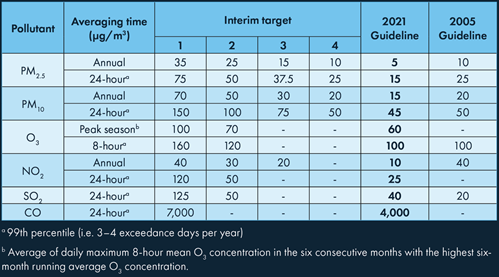The World Health Organization (WHO) has published a revised set of guidelines for PM2.5, PM10, ozone (O3), nitrogen dioxide (NO2), sulphur dioxide (SO2) and carbon monoxide (CO)
What has been released?
The World Health Organization (WHO) has published a revised set of guidelines for PM2.5, PM10, ozone (O3), nitrogen dioxide (NO2), sulphur dioxide (SO2) and carbon monoxide (CO). They update the previous guidelines issued in 2005 and are based on a review of evidence on the effects of air pollution on health, drawn from the last 16 years and more, by some of the world’s leading experts in the field.
The guidelines are not legally binding but they “provide WHO Member States with an evidence-informed tool that they can use to inform legislation and policy”.
What has changed?
In general, the Guidelines have been made more stringent, other than for SO2, reflecting developments in health effects evidence which has demonstrated impacts at lower concentrations than previously. There has also been an alignment of the Guidelines, with 24-hour values given for each of the pollutants (other than ozone), along with a series of interim targets for each. The shorter term guidelines, including the 1-hour value for NO2 (200µg/m3), have been retained unchanged.

Note that the WHO Guidelines are aimed at providing guidance on the air pollution concentration required to avoid significant health effects in the general population. They do not specify how they are to be assessed, e.g. locations where they apply, how they should be monitored, nor do they specify dates by which they should be attained. WHO states that the guidelines should apply to both indoor and outdoor settings. However, they should not be applied to occupational settings due to “the specific characteristics of the relevant exposures and risk reduction policies and to potential differences in population susceptibility of the adult workforce in comparison with the general population”.
What does this mean for the UK Air Quality Objectives?
Currently, the UK Air Quality Objectives remain unchanged. While the values for the 2005 Guidelines and the UK Objectives were similar, they were not a direct transposition and the WHO does not intend that Governments and policy makers simply cut and paste the Guidelines into legislation. However, the Environment Bill, currently nearing the end of its Parliamentary process, requires that the Government set a new target for PM2.5 and that it has regard to the WHO Air Quality Guidelines while doing so.
Planning applications are typically determined against the Objectives and not the WHO guidelines. Thus, until such time as the values for the Objectives change, there should be no practical consequence for determining planning decisions. A planning inspector recently explained, with respect to PM2.5 that while the UK Government may update its policies in response to the (previous) WHO guideline, “no numerical standard has yet been set” and “no timescale for this has been set.” “The current objective for PM2.5 is 25 µg/m3” (APP/C1570/W/20/3256619). Within London, the situation is complicated by the new London Plan, which makes specific reference to the WHO guidelines, however there is currently no consensus across local government within London how these should be interpreted.
Summary Here.
View all news